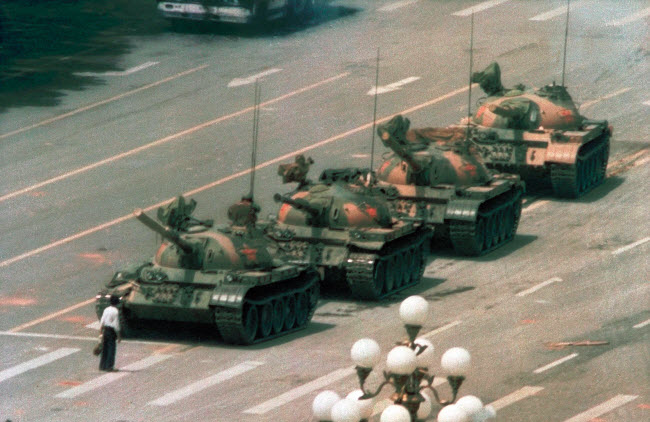Date: June 5, 1989
Photographer: American Jeff Widener – Associated Press
Details: The iconic “Tank Man” photo captures a pivotal moment during a series of protests that swept through Chinese cities in April 1989, demanding political reforms. One of the major sites was Tiananmen Square in the Chinese capital, Beijing, led by a group of university students. The Chinese government decided to confront the protests with force. On June 4, the authorities declared martial law and sent the People’s Liberation Army, accompanied by a fleet of tanks, to occupy parts of central Beijing. The troops fired into the square in what is known as the “Tiananmen Square Massacre.” Estimates of the death toll range from several hundred to thousands, with tens of thousands wounded.
A day after these events, as a column of tanks moved through the streets, a lone man stood in front of them. The reporter Stuart Franklin of Time magazine recounts that, after the tanks had left Tiananmen Square, a solitary protester in a white shirt and black trousers, carrying shopping bags, stood in front of the lead tank. The tank attempted to maneuver around him, but the man persistently blocked its path, preventing it from advancing. The tank eventually stopped, and the man climbed onto it and spoke with the crew. After their conversation, the tank’s engine was restarted, but the man again stood in its way. Shortly thereafter, two men in blue uniforms appeared, quickly removed the protester, and disappeared with him into the crowd.
The identities of these two men remain unknown. Some believe they were police officers, while others think they were concerned passersby. The identity of the “Tank Man” remains uncertain. Speculation includes that he was a 19-year-old student named Wang Weilin, accused of political offenses, and that he was either executed shortly after the events or is alive in China or has fled to Taiwan. Years later, Chinese President Jiang Zemin was asked about him but could not confirm whether he had been arrested, though he was certain he was not killed and did not know his current whereabouts.
Jeff Widener, the photographer, recounts that he was in Beijing covering the events. On June 4, he was hit in the head by a stone thrown by a protester. Despite having the flu, he continued photographing from the sixth-floor balcony of the Beijing Hotel, facing the square. When he saw the man standing in front of the tanks, he was initially frustrated because he thought the presence of the man would ruin his shot. However, what happened next turned the image into one of the most iconic photos. After taking the picture, Widener feared arrest and the confiscation of the film, but it was smuggled out by one of his assistants to international news agencies. He only realized the photo’s significance years later when it was selected as one of the top 10 unforgettable images of all time, marking his first realization of achieving something extraordinary.
The “Tank Man” photo is considered one of the most iconic and impactful images in history. It was nominated for a Pulitzer Prize and listed among the top 100 photographs of all time by Time magazine. It was also selected by AOL as one of the top ten images ever taken, due to its profound global impact, though it remains banned in China.
